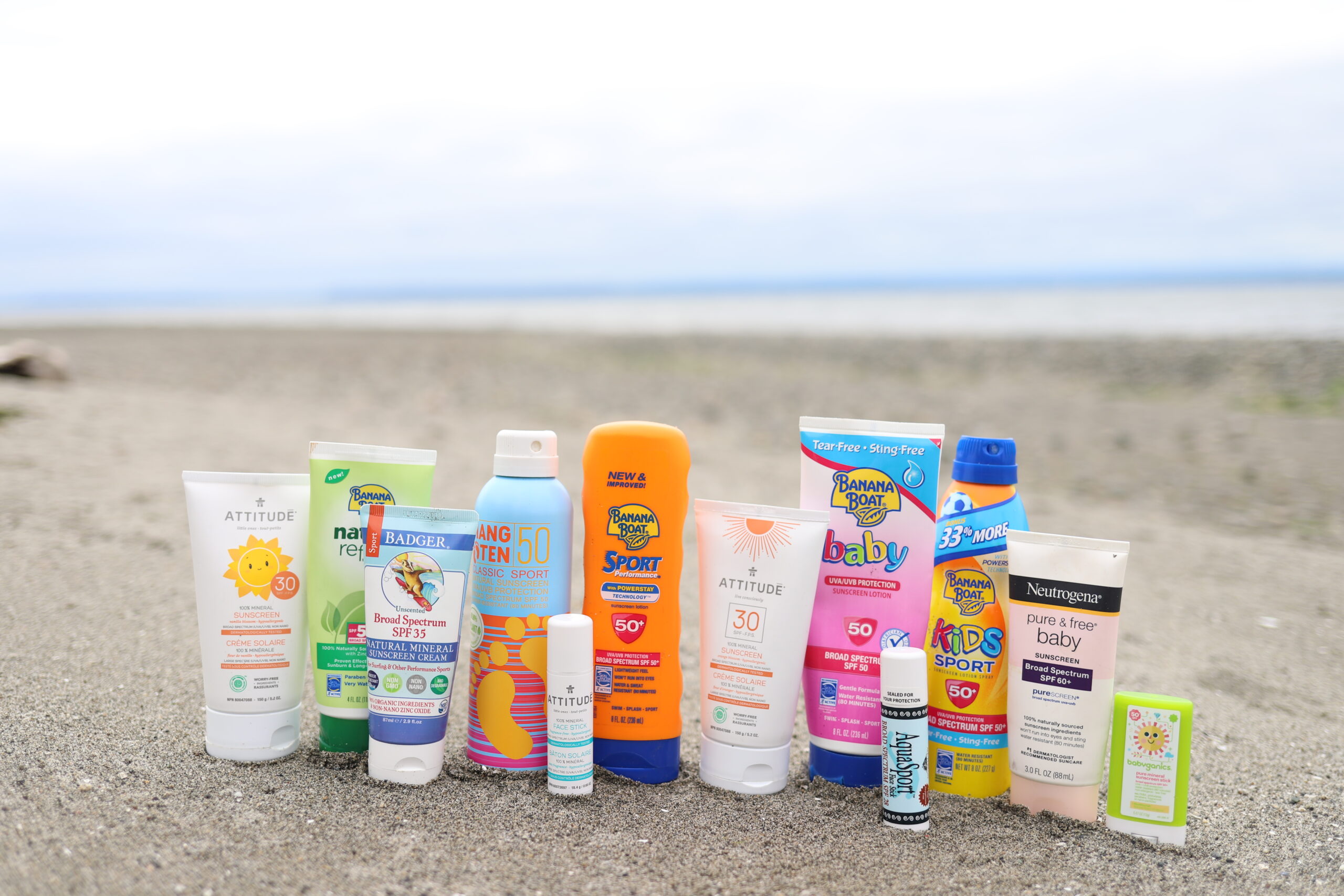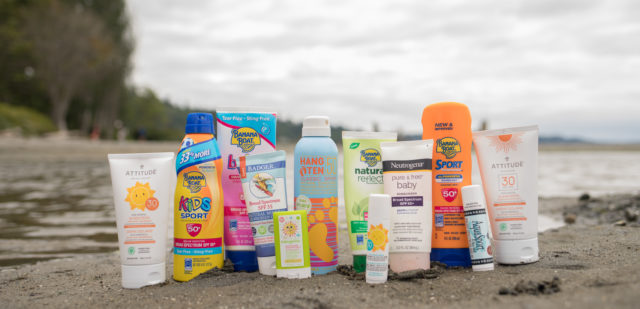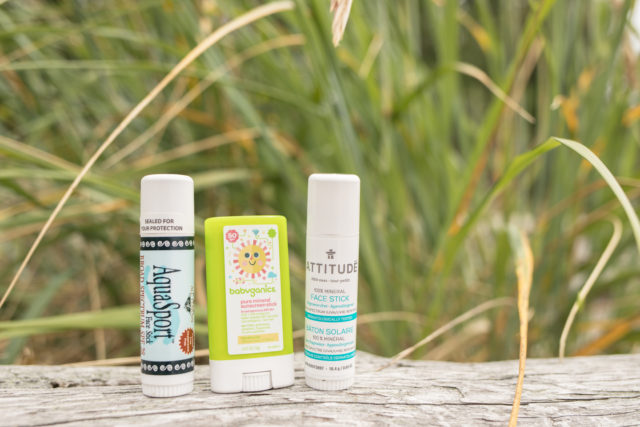
[su_expand height=”20″ link_color=”#a6e0e0″ more_icon=”icon: angle-double-down” less_icon=”icon: angle-double-up”]This post contains affiliate links. By doing so, I can easily provide examples for you guys to reference for post related products. If you buy something through a link I provide, I may receive a small commission. You will not be charged extra and may even receive a discount! I promise to only refer to things I use, love and/or highly recommend. Read more here.[/su_expand]
Before we begin, almost all the sunscreens shown above are not “natural” or “reef safe”. Keep reading to find out which ones are! Okay, now that I got that out of the way, did you know that a majority of the sunscreens on the market today contain ingredients that can disrupt hormones, cause skin allergies, speed the development of skin cancer and kill our reefs?! Well, obviously they’re banned and hard to get right? Unfortunately not, most of the common and easily attainable sunscreens are full of chemicals that are horrible for humans and are causing damage to the earth, like bleaching coral reefs. With the summer rays already hitting pretty hard in places, make sure you know what to look for AND what to avoid when shopping for sunscreens this summer.
RELATED: The Ultimate Summer Bucket List with Kids!
How to Travel with Car Seats & Why You Want to!
Because many of the ingredients in sunscreen are absorbed into the body and can affect our health, it is important to make sure you pick a good sunscreen.
“Sunscreen is a unique body care product: consumers are directed to apply a thick coat over large areas of the body and reapply frequently. Thus, ingredients in sunscreen should not be irritating or cause skin allergies, and should be able to withstand powerful UV radiation without losing their effectiveness or forming potentially harmful breakdown products. People can potentially inhale ingredients in sunscreen sprays and ingest some of the ingredients they apply to their lips, so ingredients must not be harmful to lungs or internal organs. Further, sunscreens commonly include ingredients that act as “penetration enhancers” and help the product adhere to skin. As a result, many sunscreen chemicals are absorbed into the body and can be measured in blood, breast milk and urine samples.” – EWG
So what does make most sunscreens available, so bad? The following list of ingredients are commonly found in commercial sunscreens, have poor ratings (or not effective in sunscreen), can cause skin sensitivity/allergens, health issues (like disrupting endocrine and hormones), speed up skin cancer (wait- what?) and more. Plus I included the EWG’s health rating next to them, with 1/2 being “low hazard”, 3-6 “moderate hazard” and 7-10 being “high hazard”.
* Avobenzone has a pretty high score on the list because it is not particularly harmful by its self. You may know it as a popular ingredient in anti-aging creams. But this inactive ingredient actually breaks down in the sun… now, how is that going to protect you in your sunscreen? In order to combat this, they mix in stabilizing chemicals (ick!).
**While both sunscreen and insect repellent have positive benefits when applied separately, the same can’t be said when the two are combined into a single product. The effectiveness of the sunscreen blocking harmful UV radiation has shown a reduction of more than 30% in SPF. And the toxicity of the repellent is increased by sunscreen.

Keep reading to see which of these made the safe/natural/reef safe list below! P.S. Most didn’t!
When you are in or near water, the sunscreen washes off your body and enters the marine environment. When that happens, the following common chemical sunscreen ingredients can kill coral, harm animals and damage coral reefs…
Oxybenzone, for example, is toxic in four different ways: it damages the DNA which can lead to cancer and developmental abnormalities, it is an endocrine disruptor, causes deformations in juvenile corals, and lastly, it bleaches coral reefs.

AquaSport, Babyganics, and ATTITUDE are all safe face stick options. The AquaSport and ATTITUDE, in regards to the application process are our favorites. Both go on clear and do not need to be rubbed in. Although I still do, just to make sure no spots were missed.
The EWG just released The 2018 Guide to Sunscreen. Which shows the 216 beach & sport sunscreens that met their criteria. Important: While it can be a great place of information, read through the ratings very carefully on there. I found a lot of “natural” sunscreens with good ratings but contained ingredients marked as a moderate or high hazard. It took me a few days to go through the whole list, but I was able to further narrow it down, so I was only recommending sunscreens that met the additional following criteria.
Without further ado, here are the best of the best sunscreens. (If you are a visual person like me, you might prefer the list in picture format. You can view these clickable images directly under this list).
Important: Make sure to pay close attention to specific names. While any given brand can have an awesome choice, it doesn’t mean all of the options from that brand are good ones. For example, I recommended four options from the brand Bare Republic Minerals above. But there are another 16 options from the brand, that didn’t pass my strict list of qualifications above. It’s easy to get confused with so many options, similarities, and unfortunately, the good sunscreen options are not as easy to find as the chemical filled ones… Which is why I linked everything in bold, so you can easily find the correct ones online. Comment below where your favorite place to find good natural sunscreens are.
Besides sunscreen, there are many other ways that you can protect yourself and family this season. The best way to block the rays is shade. You can do so by…

[pin_board url=”https://www.pinterest.com/pnwmamabear/pnw-mama-bear-family-travel-family-lifestyle-blog/” size=”custom” image_width=”100″ board_width=”900″ board_height=”450″]